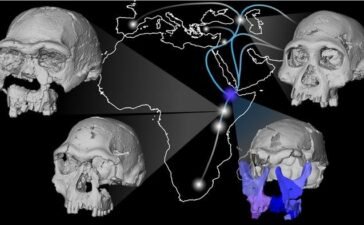Jan Bartek – AncientPages.com – Homo erectus demonstrated the ability to adapt and thrive in desert-like environments as far back as 1.2 million years ago. Research published in Communications Earth & Environment indicates that their behavioral adaptations included consistently returning to specific rivers and ponds for freshwater over thousands of years and developing specialized tools. This adaptability potentially expanded their geographic range.
There has been considerable debate regarding when early hominins developed the capability to survive in extreme environments like deserts or rainforests, with previous studies often suggesting that only Homo sapiens possessed such adaptability.
Researchers gathered archaeological, geological, and paleoclimatic data from Engaji Nanyori in Oldupai Gorge, Tanzania—a significant early hominin archaeological site. They found that between approximately 1.2 million and 1 million years ago, semi-desert conditions prevailed there, characterized by distinct plant life.
The archaeological evidence shows that groups of H. erectus adapted by frequently visiting freshwater sources such as ponds and creating specialized stone tools like scrapers and notched tools (denticulates), likely used to enhance butchery efficiency.
The study’s authors propose that these findings reveal a greater adaptability of H. erectus to extreme environments than previously recognized. Their conclusions challenge earlier theories suggesting only H. sapiens could adapt to such ecosystems, indicating instead that H. erectus might have been a generalist species capable of surviving across diverse landscapes in Africa and Eurasia.
“Palaeoclimate and vegetation model simulations4,5 suggest that environmental conditions in northern Tanzania may have been moderately favorable for hominin occupation during MIS 30. The multi-proxy, field-based palaeoenvironmental reconstructions for the Oldupai region we present here do not support those simulations, and instead imply that conditions were characterized by extreme dryness.
Biome models overestimate the extent of woodlands, as we find little evidence for this vegetation in the biogeochemical sequences we analyzed.
Furthermore, during MIS 30 Oldupai Gorge is characterized by lake desiccation, saline/alkaline soils, desert red-bed formation, and increased wildfires. Under such environmental conditions, the landscape was dominated by xerophytic ephedroid shrublands and would not have been ecologically suitable for woodlands.
Despite the challenges posed by drylands, they likely played a crucial role in conditioning early human behaviour, technology, dispersals, and ecological expansions through Africa, the Levant, and Arabia.
See also: More Archaeology News
The new datasets from Engaji Nanyori underpin the study’s conclusion that Homo erectus exhibited far greater adaptability to diverse ecologies than previously understood, with a capacity to persistently occupy extreme environments.
Hominins showed a discerning and empirical understanding of their surrounding ecology through a combination of adaptive foraging strategies, tool use, environmental exploitation, and resource management practices tailored to their specific ecological context,” the researchers conclude in their study.
The study was published in Communications Earth & Environment
Written by Jan Bartek – AncientPages.com Staff Writer
You Might Also Like
Cosmic Ray Scan Of El Castillo At Chichén Itzá May Reveal Hidden Chambers
Jan Bartek - AncientPages.com - El Castillo, also known as the Temple of Kukulcán, is a prominent stepped pyramid located at...
Treasure Hunters Encounter Unexplained Phenomena In The Arizona Mountains
Ellen Lloyd – AncientPages.com - Deep in the heart of southeastern Arizona, near the Mexican border, a group of treasure...
Tragic Tale Of The Cursed House Of Atreus
Ellen Lloyd - AncientPages.com - Once the wheel of misfortune has been set in motion, it can be challenging to...
Old Fossil From Gona, Ethiopia – New Details About First Hominins To Leave Africa
Conny Waters - AncientPages.com - A team of international scientists, led by Dr. Karen Baab, a paleoanthropologist at the College of...











